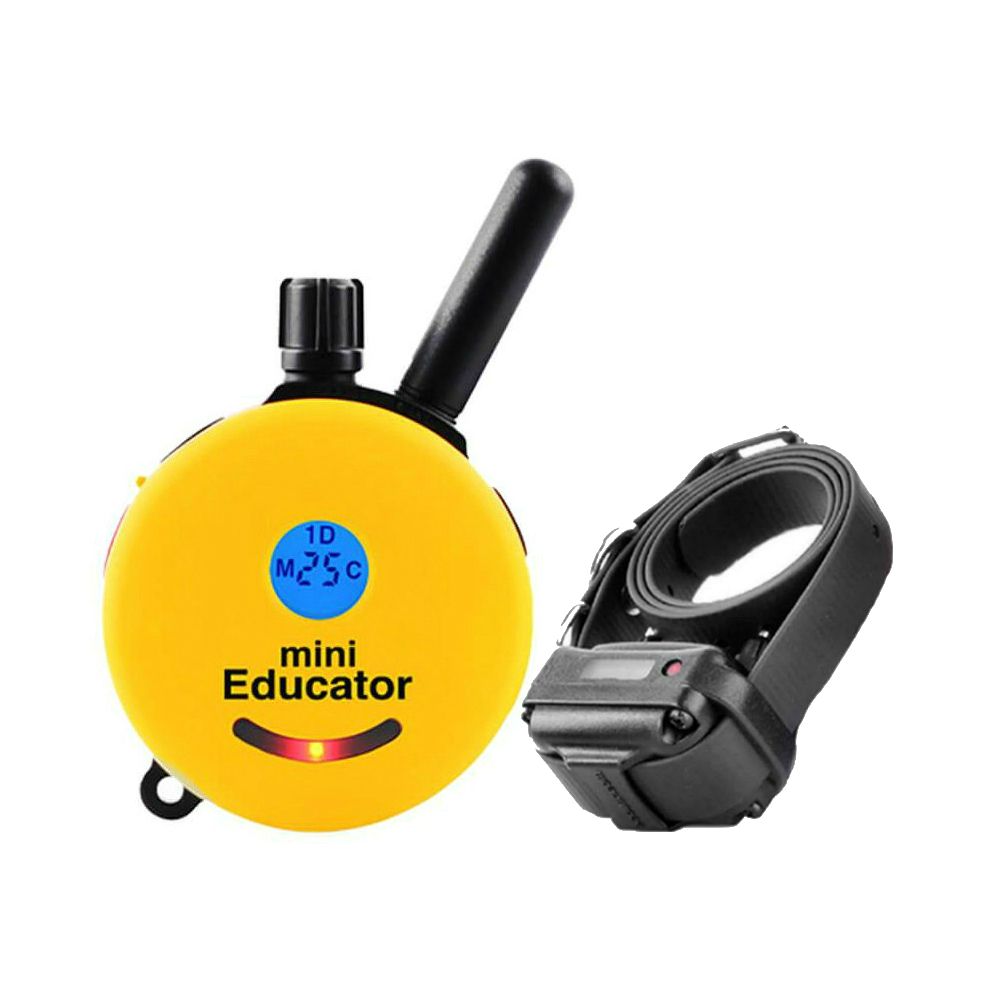In this article, I will show you how to teach your dog to “Sit” on command. Again, your dog must first know the verbal command and we will use the Tapping method at very low levels of static stimulation to reinforce this command with the use of the remote training collar.
Teach Your Dog to “Sit” without an E Collar
You should be gaining some confidence in your use of the remote trainer and your dog should be looking forward to training sessions. If your dog balks or doesn’t exhibit enthusiasm, add more fun and games to the sessions. Start and end each session with playtime and observe your pal carefully for signs of fatigue or anxiety during training. The best training atmosphere is one that is engaging and rewarding for both of you.
Remember, if your dog needs more than a week to learn the “Come” command, do not rush him. Try shorter lessons more frequently if he gets distracted. On the other hand, if your dog learns the recall in the first session, resist the urge to rush on; work with distractions instead.
Once your dog is responding immediately to the “Come” command, you will know he is ready to move on to the next lesson. He should now maintain some awareness of where you are even while he is exploring. With the “Sit” command, he will learn to sit at your side and remain so until released or given another command.
Lesson One: Teaching the Sit Behavior
Again, you will be using Positive Reinforcement to teach this lesson. When your dog responds as requested, you give him a reward. If your pet responds well to praise alone, fantastic, but if not, use a food treat or toy to reward his compliance.
For this lesson you will have your dog at your side. Apply pressure to the underside of your dog’s neck by lifting straight up on the lead while your other hand pushes his butt gently but firmly into the sit position. When his bottom contacts the ground release pressure and say, “Sit.” Immediately reward/praise him. Repeat. It is okay if he pops back up the first few times; you will train him to stay in a later lesson. As always, mix up the session with lots of play. Make it fun!
Next, command “Sit” and apply upward lead pressure simultaneously. Fairly quickly, your dog should be sitting on the command without the need for downward pressure on his bottom. When he sits, reward him and then release him immediately to play for a few minutes before repeating.
REVIEW
• With one hand on your dog’s rump, push down while pulling straight up on the lead simultaneously.
• As his bottom hits the ground command “Sit” and reward/praise him. Repeat.
• Next, give the command and pull up on the lead simultaneously.
• Reward/praise when he sits then release him to play or explore. Repeat.
Lesson Two: Adding the Command
Still working with him at your side, and once he is sitting on command without much coaxing, begin to give the command without any lead pressure. If he hesitates, repeat the command and pull up on the lead. Praise him modestly when he sits. Repeat and release. When your dog is responding to the command promptly without any leash pressure and awaiting your praise, you will know he understands. With each repetition, increase the length of time he remains sitting before he is released to play.
REVIEW
• Give the “Sit” command without any physical cue.
• If he hesitates, pull up on the lead until he sits, then praise.
• Repeat until he responds without physical cuing.
• When he is watching for your command, he understands.
• Increase the length of time before you release him.
Lesson Three: Come and Sit
Now you will put it together. You’ll teach your dog to come to you and sit at your side awaiting your command.
With your dog on a long lead, let him explore. Give his recall command, “Come,” and when he gets right in front of you command, “Sit.” If he doesn’t sit, repeat the command and position him to sit at your side. If he sits in front of you, praise him and release him to play. Call “Come” again, and command, “Sit,” gesturing to where you want him to sit when he arrives. If he sits in front of you or anywhere except at your side, move him to your side, praise and release. Repeat as many times as it takes until he sits at your side. Make a big show of celebration when he finally succeeds. To avoid confusion, you must decide the degree of precision that you expect and hold him to that standard from the beginning of training.
REVIEW
• On a long lead, practice recall followed by the “Sit” command.
• Position him at your side before rewarding.
• Release and repeat.
• When he sits in the correct place, praise and reward, then playtime.

Teach the “Sit” Command with the eCollar
Never teach a command using an electronic collar. Your dog must have already demonstrated understanding of the “Sit” command before you can proceed to training with your e-collar. Some dogs are very responsive to their owner/handler, obeying without hesitation. These dogs may not need additional training. Or, your dog may only need it for certain commands or only for problem behaviors (see Chapter Three). Just like people, some dogs are stubborn or easily distracted. These dogs often respond well to aversion training with a remote trainer.
In this lesson your dog will learn to understand that when you give the command he is to sit and remain so until you release him. If your companion is to be reliable both on- and off-leash, you must train him to respond as you have conditioned him, rather than to respond instinctually. You will accomplish this by reinforcing the “Sit” command with electronic stimulation. Using Negative Aversion, your dog will learn to respond to your command immediately in order to turn off the eCollar stimulation.
Lesson One: Reinforcing the Sit Command
You will need an assistant for this lesson to introduce distractions. These can be skateboards, bicycles, dogs, cats, joggers or anything that will grab your dog’s attention. Start with your dog at your side. Command “Sit” a few times without using any stimulation to remind him of what is expected and to give him a few successes.
Then, after he is seated, cue your assistant to introduce the distraction. The instant your dog moves, begin tapping the remote and command “Sit.” Continue tapping until he does. Apply upward pressure on the lead if necessary to help him sit. The moment his bottom hits the ground stop tapping and reward/praise him.
If he gets up before you release him say, “Sit” again and tap the remote until he complies, then release him. Engage in play for awhile before repeating the lesson. Be sure to calmly praise your dog when he sits without moving in the presence of a distraction. If you praise too lavishly, he may become excited and jump up again. Gradually increase the level and number of distractions, making sure to not over-tax your canine student. This step in training is very important to master and will require patience. You’re conditioning your dog to resist his instinct and to do as you command.
REVIEW:
• Remind your dog of what you expect when you command, “Sit.”
• When he is seated, introduce a distraction.
• When he moves tap the remote and command “Sit” again.
• Use upward pressure if needed to encourage him to sit.
• Stop tapping the instant his butt hits the ground.
• Reward/praise and release.
• Repeat and praise him if he remains seated with distractions present.
• Increase distractions gradually.
Lesson Two:
Now that your dog has experience with how the remote trainer works – that to turn it off he must sit his butt down and stay there no matter what distractions are present – you will teach him that he must also stay seated at a distance from you. Your dog wants to be with you and has been trained to come to you, so don’t expect him to grasp this on the first try.
Let him wander around a short distance from you for a few minutes then give the command, “Sit.” If he does so, praise him then walk over and release him. If he doesn’t sit, immediately repeat the word and begin tapping on the remote. Do not let him come to you. If he does, continue tapping and go to him and have him sit then release him. He should get the idea pretty quickly. Be sure to walk over to him to release him at first. When you see he has this down, you may start calling him to you from a distance.
REVIEW:
• From a distance, give the “Sit” command.
• If he complies, praise him and go to him. Release.
• If he does not sit, tap on the remote and repeat the command.
• Stop tapping when he sits.
• Continue tapping if he comes toward you and go to him to enforce the sit.
• Repeat until he sits on command at a distance.
What if…
If your dog sits only halfway down or sits askew on one haunch, you must show him the correct position – with his butt square on the ground and his attention on you. If you demand that he sit correctly from the beginning, you will be able to address the issue easily without confusing your pupil.
If your dog exhibits anxiousness or vocalizes when you correct him, you will need to end the session immediately and engage in some playtime activity. Be sure to decrease the stimulation level for the next session. You may need to return to letting your dog wear the electronic collar for a few hours each day without doing any training.




Subscribeto get the latest dog training articles, latest offers & news.
You have Successfully Subscribed!